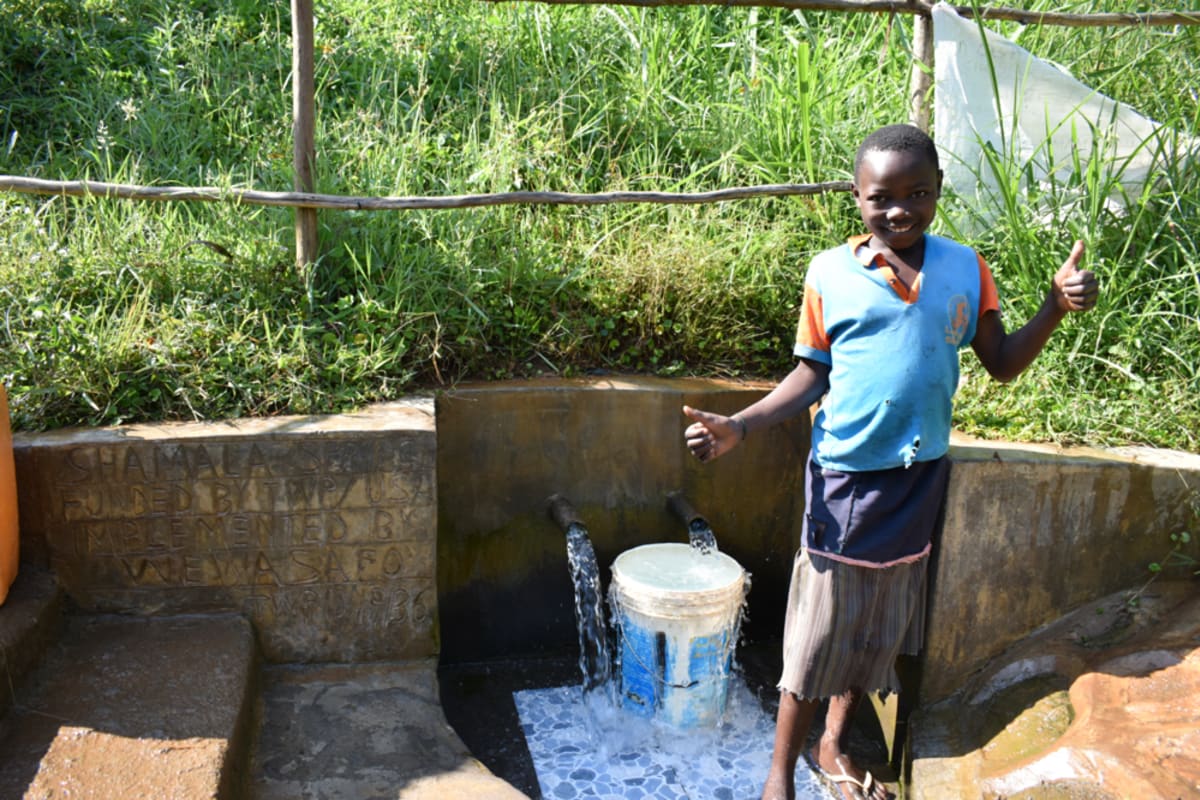Water from Shamala Spring in Malimali Community is consistently available and consistently unsafe for drinking. Upon our visit to the spring, our team reported that the spring is plagued by insects and dirty runoff from nearby farms. Once at the spring, one must dip their entire container into the spring’s reservoir puddle to fill it up, adding whatever contaminants were on the container into the water being collected. And collecting whatever contaminants were already in the water.
The most common causes of death in Malimali are typhoid and malaria, which community members say are directly connected to their water source at Shamala Spring. These sicknesses are not only a big health concern, but they also place a great financial strain on the community members who are trying to pay for treatment and medicine.
"As much as some of us ignore the fact, these typhoid cases are very much from the water we consume and it has cost us a lot financially, mentally, and physically," said Nifreda Matende, a farmer and trader in Malimali.
Knowing their water source is unprotected, community members do their best to make it safer by boiling it, letting it cool, then pouring it through a sieve to strain out large particles of dirt and sand. A lot of time is wasted throughout this lengthy process for every bucket of water collected. The water is then stored in whatever containers are on hand, but the frequency of cleaning out the stored water is concerning. Most households only change out the containers after they notice large particles of algae or other growths in it.
The day of our visit was rather hot as the sun was up early and a lot of cloud cover filled the skies. Getting to Malimali community, one immediately notices the mixture of traditional and modern housing. This suggests the village is on the upward trend of development, but its community members are being held back in part due to the unsafe water they rely on at Shamala Spring.
The village is quiet due to the scattered and unoccupied homesteads during the day, when most residents go to work on their farms. The area is well-vegetated with large farms and enough grass-covered land for children's playgrounds as well as the airing of produce like maize and groundnuts. Most community members are involved in agricultural practices for their livelihoods. Other occupations include small scale businesses like selling in shops or small kiosks, motorbike taxis, and teaching.
Families here are small, though they live as an extended family on the same piece of land. The parents work on different jobs to bring food to the table while the older children are tasked to take care of the home and their younger siblings during the day. People gather together for religious meetings, feasts to celebrate lives lived, and weddings.
Malimali comes to life every day beginning at 6:00 am, and the intensity of the day's schedule varies depending on the day of the week and season. On market days, the area is busiest early in the morning and very late in the evening. On a normal day, the woman in the house, usually the wife, gets up earliest to prepare the meals and do some cleaning. She is also responsible for getting water from the spring for daily activities like bathing and cleaning dishes. Preparing the children for school is also her responsibility.
The men get up later, eat breakfast, and leave to do their various occupations. The rest of the day is usually deserted in most compounds until 3:00 pm when the children come back from school. They help their mothers store away any aired produce, then settle down in groups to play. The women then take charge and prepare dinner as the men either sit in groups for small talk, graze their cattle, or milk the cows.
There are some latrines in Malimali, which are kept as clean as possible since people are cautious to avoid having a rotten wooden floor. There is no water kept nearby to aid in the cleaning or handwashing, but they do sprinkle ash over the opening to keep them clean.
"These toilets of ours are not safe," said Alex Ogada, a farmer in Malimali.
"With the [body]weight some of us possess, we fear that at some point the wood may fail to hold. The toilets themselves can't be washed with water regularly to avoid the boards from rotting. It is a challenge and a risk to use these toilets."
Everyone we talked to during our visit expressed their cry for help to change their water situation. They also offered their support for any effort or help required of them to change their situation.
What we can do:
Training
Community members will attend hygiene and sanitation training for at least 2 days. This training will ensure participants have the knowledge they need about healthy practices and their importance. The facilitator plans to use Participatory Hygiene and Sanitation Transformation (PHAST), Community-Led Total Sanitation (CLTS), Asset-Based Community Development (ABCD), group discussions, handouts, and demonstrations at the spring. One of the most important topics we plan to cover is the handling, storage, and treatment of water. Having a clean water source will be extremely helpful, but it is useless if water gets contaminated by the time it is consumed. We will also emphasize the importance of handwashing.
Training will result in the formation of a committee that will oversee the operations and maintenance of the spring. They will enforce proper behavior around the spring and delegate tasks that will help preserve the site, such as building a fence and digging proper drainage channels. The fence will keep out destructive animals, and the drainage will keep the area’s mosquito population at a minimum.
Sanitation Platforms
On the final day of training, participants will select 5 families that should benefit from new concrete latrine floors. Training will inform the community and selected families on what they need to contribute to make this project a success. They must mobilize locally available materials, including bricks, clean sand, and gravel. The 5 families chosen for sanitation platforms must prepare by sinking a pit for the sanitation platforms to be placed over. All community members must work together to make sure that accommodations and food are always provided for the work teams.
Spring Protection
Protecting the spring will help provide access to cleaner and safer water. Construction will keep surface runoff and other contaminants out of the water. With the community’s high involvement in the process, there should be a good sense of responsibility and ownership for the new clean water source.
Fetching water is predominantly a female role, done by both women and young girls. Protecting the spring and offering training and support will, therefore, help empower the female members of the community by giving them more time and efforts to engage and invest in income-generating activities.

 Protected Spring
Protected Spring
 Rehabilitation Project
Rehabilitation Project











































